The Chromebook Pixel (2015) Review
by Brandon Chester on March 16, 2015 8:00 AM EST- Posted in
- Laptops
- Chrome OS
- Chromebook
- Chromebook Pixel
Display
When the original Chromebook Pixel launched two years ago, its big selling point and the source of its name was its 239ppi 2560x1700 display. At that time, the only other laptops on the market with HiDPI displays were Apple's Retina MacBook Pros. Chromebooks have typically aimed for the low-cost segment of the laptop market, and so it was quite a surprise that one of the earliest HiDPI laptops was a Chromebook. Although the Pixel had the highest pixel density of any laptop display at the time, it fell somewhat short when it came to color reproduction due to its narrow color gamut and lack of calibration. With the new Chromebook Pixel, Google has advertised coverage of the sRGB color gamut, along with a maximum brightness of 400nits.
To see whether or not Google has hit their mark, we turn to our standard display testing workflow. As usual, all measurements are performed using SpectraCal's CalMAN 5 software along with X-Rite's i1Pro 2 spectrophotometer, with the exception of black level measurements which are performed with an i1Display Pro colorimeter.
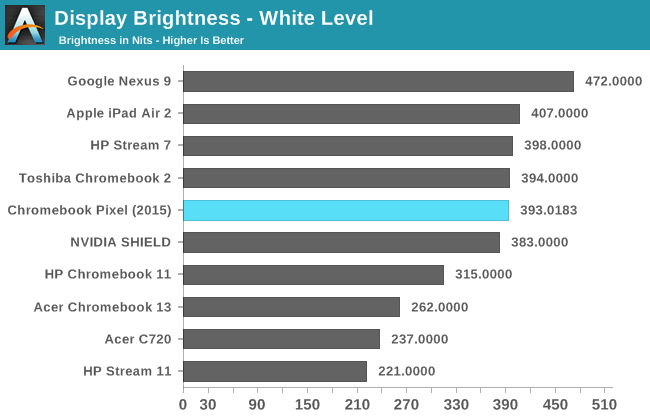
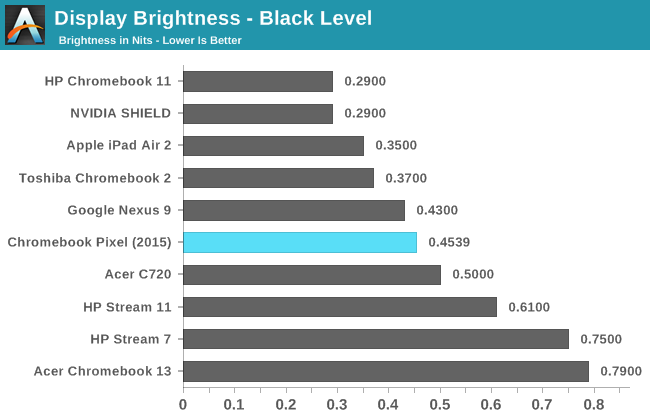
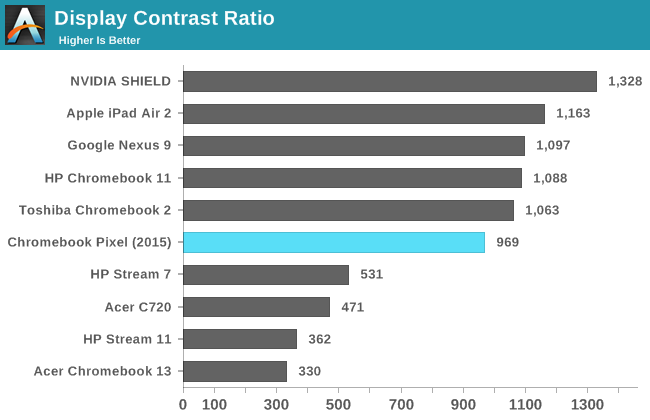
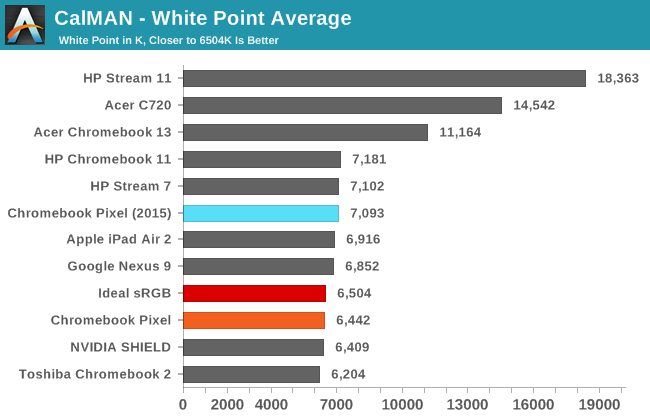
Due to the evolution of our display workflow as time has gone on, I don't have results to compare the new Pixel to the original for certain categories. The result for maximum brightness is certainly in line with Google's advertised 400nit brightness, while the black levels and contrast ratio are what you would expect of IPS panels. The white point is noticeably more blue than the ideal D6504 target, which contrasts with the original Pixel which was very slightly too red. The blue/green tint in white and shades of grey is also more obvious than most other devices with similar average white points, which I elaborate on further below.

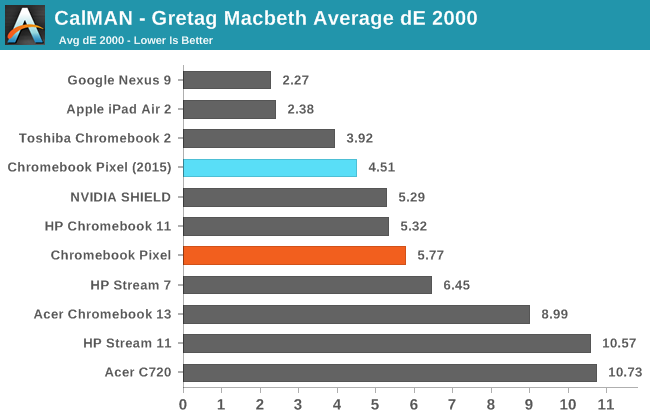
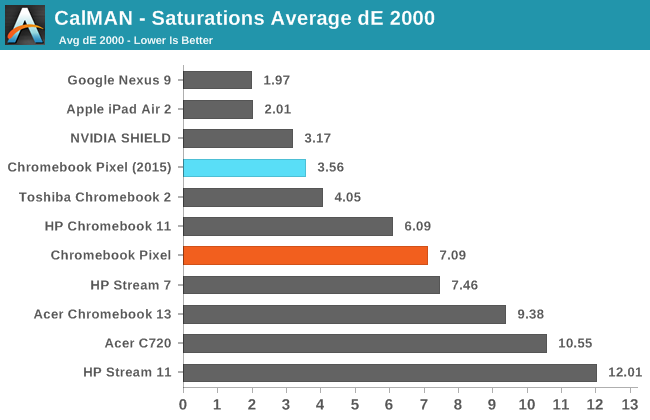
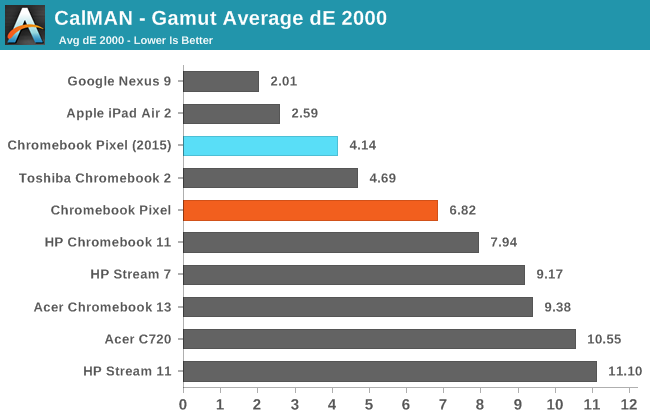
The new Pixel improves significantly upon the original in the gamut and saturation tests. It has a much wider gamut than the original, although it misses in magenta and yellow. Saturation improvements follow the improved gamut, as colors of 80% and 100% saturation no longer look identical. Despite these improvements, there hasn't been much progress on greyscale and color mixture accuracy. As noted earlier, the Pixel has a fairly obvious green/blue tint to the lighter shades of grey and white. As you can see in the gallery below, this is due to the reduction in red and increase in blue components of luminance as the shades of grey move from black to white.
I don't expect that many Chromebook users will be doing heavy photo and video editing that requires a perfectly calibrated display. Many $999 laptops ship with displays that are much worse than the one on the new Pixel, and I think that most users will be very happy with the Pixel's display. It's just a shame that Google doesn't seem to have put the same amount of care into display calibration with the Pixel as they have with the Nexus 9 and other Google branded devices, despite it having the highest price point of the devices they sell.
















123 Comments
View All Comments
Selden - Tuesday, March 17, 2015 - link
New Macbook: mobile processor, 480px camera, *1* USB Type-C port, 5 Gb iDrive space. $1299.New Pixel: i5, 720px camera, 2 USB Type-C, two USB Type A ports, 1 Tb of Google Drive space for 3 years. $999
I'
BackInAction - Monday, March 16, 2015 - link
I don't think Google intends for this to be something Joe Public will purchase. More of a ChromeOS Developer tool?Any comparison between this and other laptops is meaningless because it isn't meant to be compared with anything.
chlamchowder - Monday, March 16, 2015 - link
I don't know if it's the best idea to develop for a device more powerful than what most of the userbase will buy.The 64 GB version looks like a decent platform to put Linux on, as long as you don't try to store too much. After all, the lowest end original Surface Pro had 64 GB, and Windows programs tend to be heavier on storage. But I'm not sure I'd pay $1300 to tinker with Linux on it.
coder543 - Monday, March 16, 2015 - link
In general, developer machines *have* to be more powerful than the consumer machines the software will run on. Just because you're developing on a powerful rig, doesn't mean you won't test your software on weaker hardware along the way.It's not exactly the same thing, but a great example of this is game development. I literally could not run the Unreal Engine 4 development tools reliably on a Mac mini with 4GB of RAM. It would crash often due to running out of memory. Once I upgraded it to have 16GB of RAM, these problems all disappeared. UE4 allows you to develop games for everything from smartphones to the most powerful desktops, yet there is absolutely no way you could run the developer tools on a smartphone -- even if it is the platform you're targeting, and you don't think it's good to develop on more powerful hardware than you're targeting.
chlamchowder - Monday, March 16, 2015 - link
I said develop for, not develop on. I really doubt developers will want to code right on Chrome OS. They're probably following a similar model to cell phone app development, where you write/compile your code on a 'real' machine, and then package/deploy it to a test machine (cell phone, or Chromebook).With that model, using the Chromebook Pixel as a test platform might not be the best idea. An app that performs decently on the Pixel might not do so well on lower end Chromebooks.
I suppose you could drop a full blown Linux distro or Windows on a Chromebook Pixel and use it for coding...but then limited storage could be an issue.
extide - Monday, March 16, 2015 - link
But its not a *testing* platform, it's a *developing* platform. Also, great for users who'd like to put Linux on.chlamchowder - Monday, March 16, 2015 - link
Developing *on* Chrome OS seems like a horrible idea, even on the Pixel.To start, Chrome OS doesn't come with any development tools (though there's a messy way to get GCC on it). Assuming you manage to get a build environment set up, you then have to deal with very limited storage. Want to store local copies of several large projects? GLHF. Then, what about compilation times? A Broadwell i5 ULV chip is great for an ultrabook, but a desktop with an adequately cooled, higher clocked i7 will blow it out of the water.
Any laptop or desktop for the same price is much better for coding.
melgross - Monday, March 16, 2015 - link
A developer tool doesn't need to be made out of aluminum. No, Google is clearly trying to make a high end laptop to compete with Apple. Since Chrome still isn't nearly as useful as either Windows of OS X, this is a very limited device. Are they worth more than $1,000? No way nearly.Hanoveur - Monday, March 16, 2015 - link
No, Google is on record saying they gave these away to the developers at the Google Developers Conference and were simply making them available for the general public to buy. They aren't expecting to sell many of them. Look it up.And why wouldn't someone buy this? People could buy a Toyota Corolla to simply drive from point A to point B, but there are those that choose the Infinity to do exactly the same thing. It's all about preference. It might seem insane to some people, but people like what they like. Everyone elses world and tastes do not revolve around yours.
chlamchowder - Monday, March 16, 2015 - link
It's just difficult to imagine who's tastes this would fit.